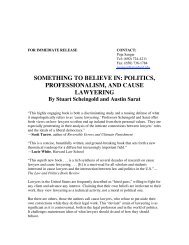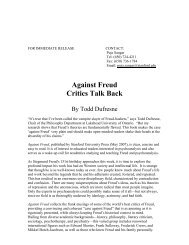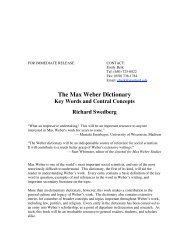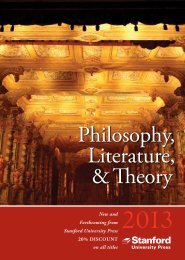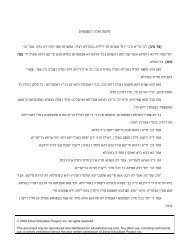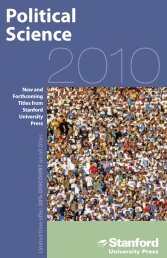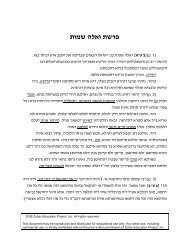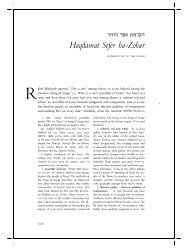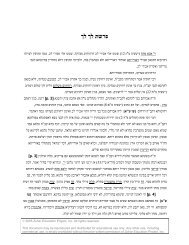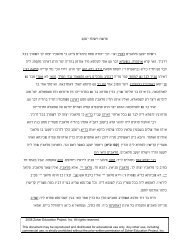Front Matter (PDF) - Stanford University Press
Front Matter (PDF) - Stanford University Press
Front Matter (PDF) - Stanford University Press
Create successful ePaper yourself
Turn your PDF publications into a flip-book with our unique Google optimized e-Paper software.
in the settingof the rabbinic world. But aggadah also includes tales of<br />
landscape<br />
rabbis themselves and teachings of wisdom in many forms: maxims, para-<br />
the<br />
folk traditions, and so forth.<br />
bles,<br />
kabbalists made great use of the midrashic/aggadic tradition, drawing<br />
The<br />
both its methods of interpretation and its contents. The hermeneutical<br />
on<br />
of Midrash, includingthe legitimacy of juxtaposingverses from<br />
assumptions<br />
within Scripture without concern for datingor context, the rearranging<br />
anywhere<br />
of words or even occasional substitution of letters, use of numerology and<br />
as ways to derive meaning, the endless glori®cation of biblical<br />
abbreviation<br />
and the tarringof villainsÐall of these and others were carried over<br />
heroes<br />
Midrash into Kabbalah. Indeed many of them were used by other sorts of<br />
from<br />
preachers as well. But the content of the aggadic worldviewÐwith its<br />
medieval<br />
picture of God as Creator and divine Ruler who sees everywhere; who<br />
mythic<br />
in history; who responds to prayer and human virtue, even suspendingthe<br />
acts<br />
of nature to rescue His beloved; who mourns with Israel the destruction<br />
laws<br />
their shared Temple and suffers with them the pain of exileÐall this too was<br />
of<br />
carried over into the kabbalistic imagination. In fact the kabbalists<br />
faithfully<br />
partial to the most highly anthropomorphic and mythic versions of rab-<br />
were<br />
tradition, such as were contained in the eighth-century collection Pirqei<br />
binic<br />
Eli'ezer. Here they stood in sharp contrast to the prior emerging<br />
de-Rabbi<br />
trend of the Middle Ages: Jewish philosophy, which exercised a<br />
intellectual<br />
of critical skepticism with regard to the more fantastic claims of the<br />
degree<br />
and sought out, whenever possible, those more modest and somewhat<br />
aggadah<br />
viewpoints that could be found amongcertain of the early rabbis.<br />
naturalistic<br />
is the tradition of halakhah, the legal and normative body of Talmudic<br />
Second<br />
teaching, the chief subject of study for Jews throughout the era, and thus<br />
main curriculum upon which most kabbalists themselves were educated.<br />
the<br />
early kabbalists lived fully within the bounds of halakhah and created a<br />
The<br />
that justi®ed its existence. While later Kabbalah (beginningin<br />
meaningsystem<br />
early fourteenth century) contains some elements that are quite critical of<br />
the<br />
little of this trend is evident in the period before the Zohar. Some<br />
halakhah,<br />
of KabbalahÐRabbi Moses Naḥmanides (see below) is the great<br />
transmitters<br />
also active in the realm of halakhic creativity, writingresponsa<br />
exampleÐwere<br />
commentaries on Talmudic tractates. More common was a certain intel-<br />
and<br />
specialization, undoubtedly re¯ectingspiritual temperament, spawning<br />
lectual<br />
who lived faithfully within halakhah and whose writings show its<br />
kabbalists<br />
their lives, but who devoted their literary efforts chie¯y to the<br />
patterningof<br />
of mystical exegesis, including kabbalistic comments on the command-<br />
realm<br />
or re¯ection on aspects of halakhic practice.<br />
ments<br />
third element of the rabbinic legacy is the liturgical tradition. While<br />
A<br />
praxis was codi®ed within halakhah and thus in some ways is a subset<br />
liturgical<br />
it, the texts recited in worshipÐincluding a large corpus of liturgical poetry,<br />
of<br />
Introduction<br />
xxxi<br />
or piyyutÐconstitute a literary genre of their own. Medieval writers, including



